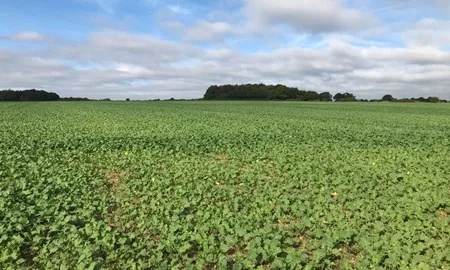
Cabbage stem flea beetle emergence can be much more prolonged than traditionally believed and volunteers from previous crops have little real value in trapping emerging adults.
Author
| 1st January 2023Tags
Latest csfbSmart findings point to better flea beetle control
Cabbage stem flea beetle emergence can be much more prolonged than traditionally believed and volunteers from previous crops have little real value in trapping emerging adults.
Cultivating OSR stubbles after harvest can, however, markedly reduce beetle emergence, while including oilseed rape in nearby cover crops as well as longer lasting companions with new plantings could be particularly valuable in reducing larval burdens.
These are among the key findings of the latest Defra-funded csfbSmart studies led by Colin Peters and his NIAB team.
Using emergence traps anchored to the ground as well as conventional water traps in OSR stubbles with growers across the country and the widest possible recording of larval numbers, the project is helping to build a better understanding of the pest and management steps that may be of practical value in reducing its impact.
Speaking at an early winter webinar to share their results, Mr Peters stressed that the much more extensive work they have been able to do this season confirms that beetle emergence from the soil builds-up rapidly in August and early September. However, it also shows that peak emergence can vary from mid-August to late September – and even early October – in some cases. And adults continue to emerge well into November.
“In south Cambridgeshire the 25mm of irrigation we were able to apply weekly from early August made no difference whatsoever to the emergence pattern,” he reported. “So, moisture appears to have little or no effect on initial beetle movement from the soil. Certainly, nowhere near the effect that the calendar does.
“Interestingly too, the adults appear to be genetically programmed to migrate from where they emerge to seek out pastures new. While we were collecting large numbers of beetles in our emergence traps, we were finding remarkably few in nearby water traps; even where delayed emergence in the dry weather meant volunteers were no more mature than newly-sown OSR locally.
“Making perfect sense biologically, this suggests volunteer rape offers limited value as a trap crop,” he stressed. “Where trap cropping with OSR may work, though, is where it’s included as part of an over-wintered cover ahead of a spring crop. This provides the adults with a fresh ‘crop’ at the young stage of development we know they prefer for egg-laying, so their larvae are eliminated with normal cover crop destruction.
“We are exploring this opportunity as well as the use of companion crops lasting well into the winter – which we have found can significantly reduce larval levels in the OSR – in more depth this season.”
Also currently being investigated in more detail as part of by the csfbSMART project is the use of cultivations to reduce CSFB populations in the soil prior to their emergence. Shallow and deep cultivation of OSR stubbles at separate Cambridgeshire sites this autumn, indeed, resulted in 63% and 90% less beetle emergence to the end of November respectively.
Independent potato expert, Martyn Cox suggested August cultivations could be as useful here as he has found them to be in controlling wireworms – reducing young adult, pupal and late-stage larval viability and exposing them to predation.
However, Dr Sam Cook of Rothamsted Research cautioned that cultivations are known to have a negative effect on important CSFB parasitoids, making care of the essence here.
“It’s early days yet,” concluded Colin Peters. “And we clearly have to be careful that anything we do to counter flea beetles doesn’t work against broader things like soil health improvement and carbon sequestration, not to mention farm profitability.
“We are currently trying to put a group together to look more fully into the whole issue of pupae in the ground and how cultivations affect both them and their all-important predators and parasitoids.
“The more we understand how the pest is living in modern rotations and work with growers to explore practical opportunities to control it within them, the more we are being able to pinpoint things that will actually help and are compatible with these and other important farming priorities.”